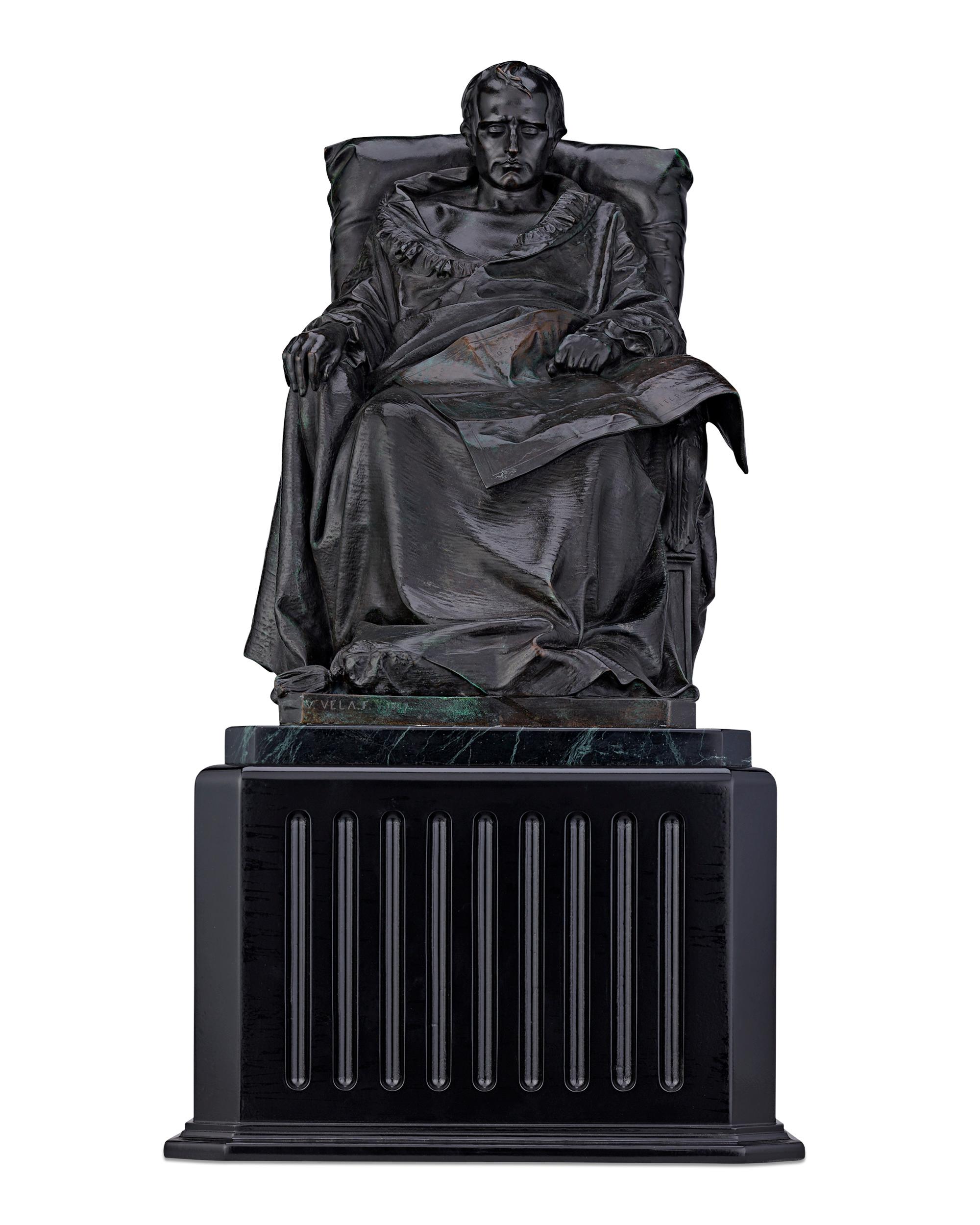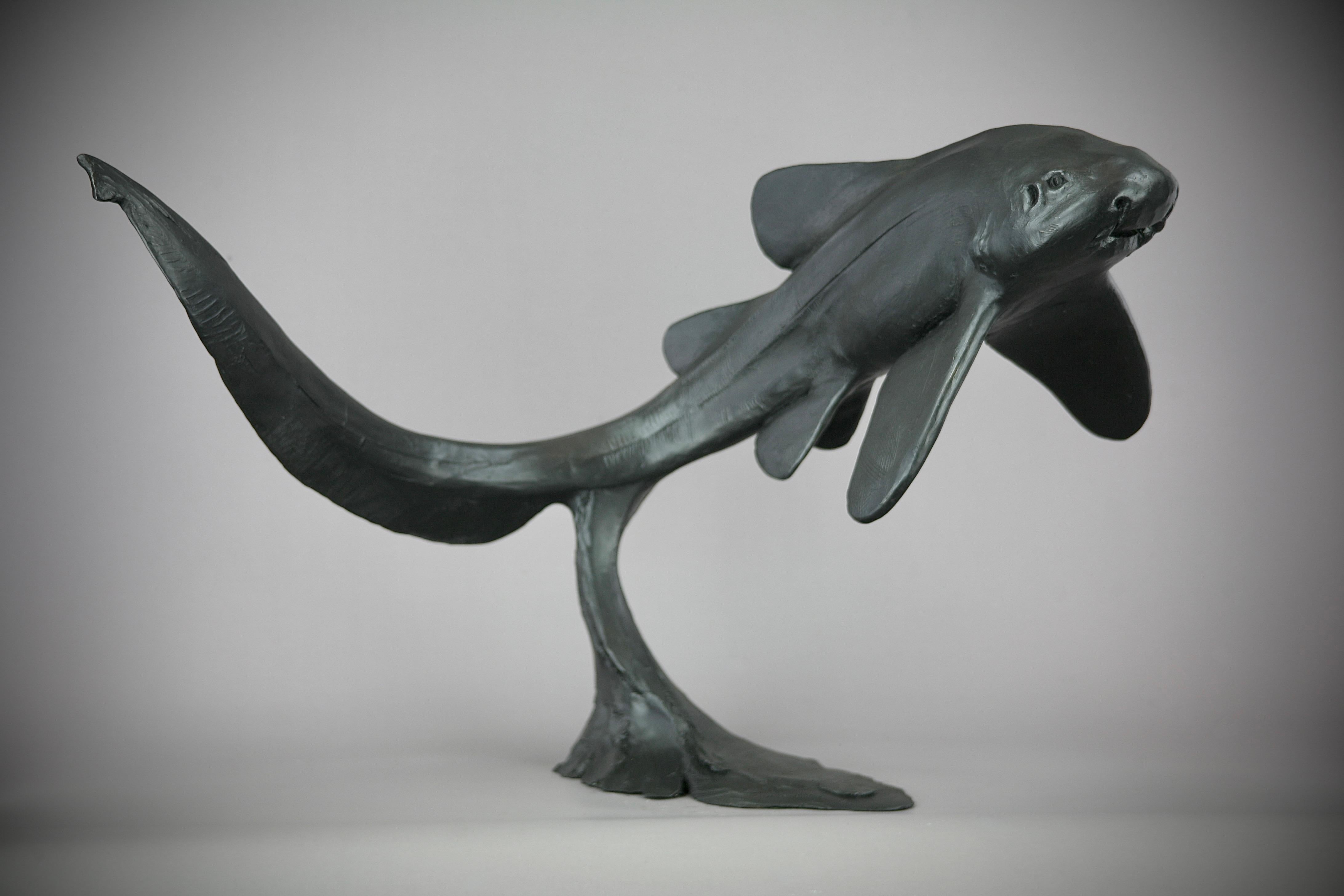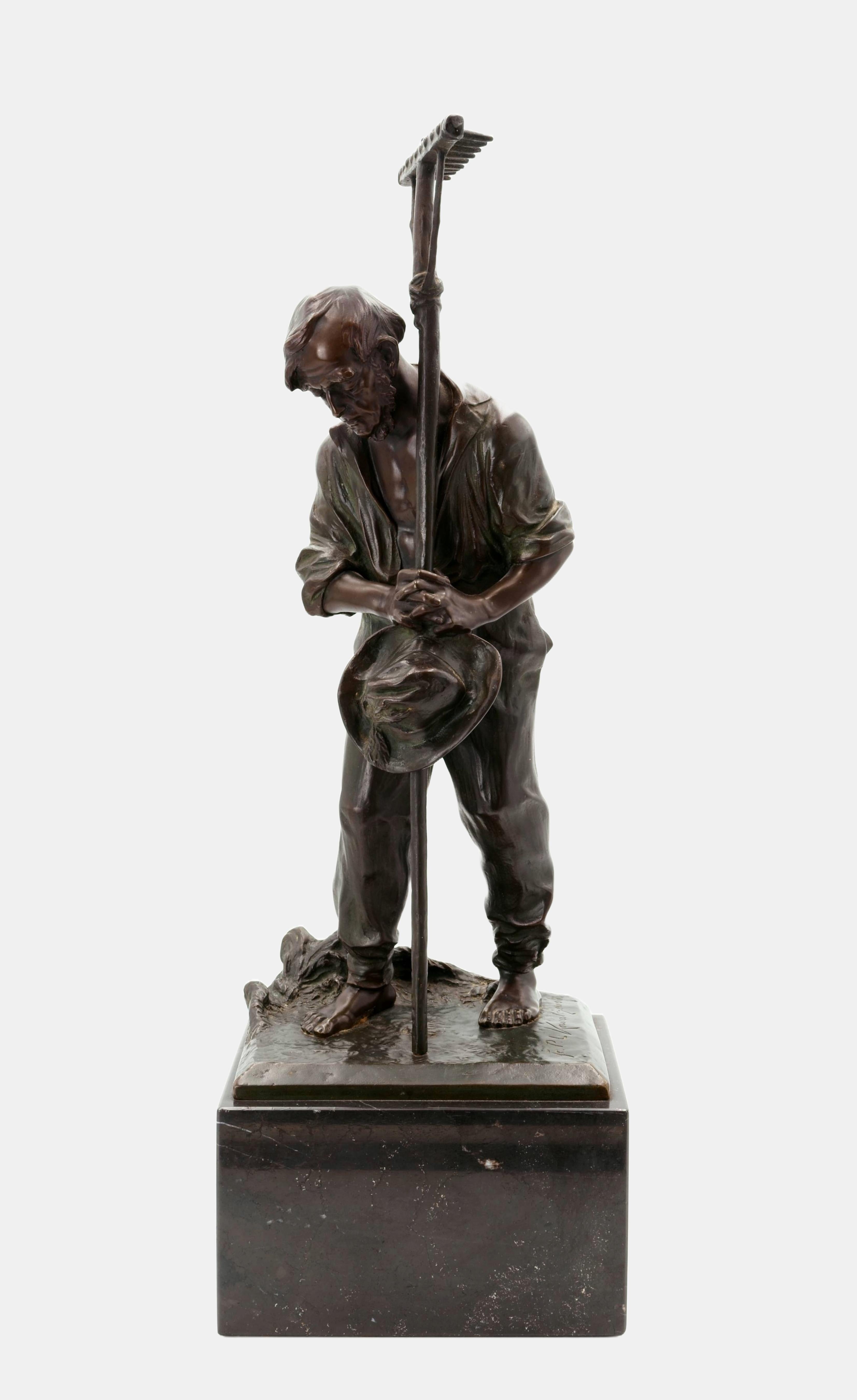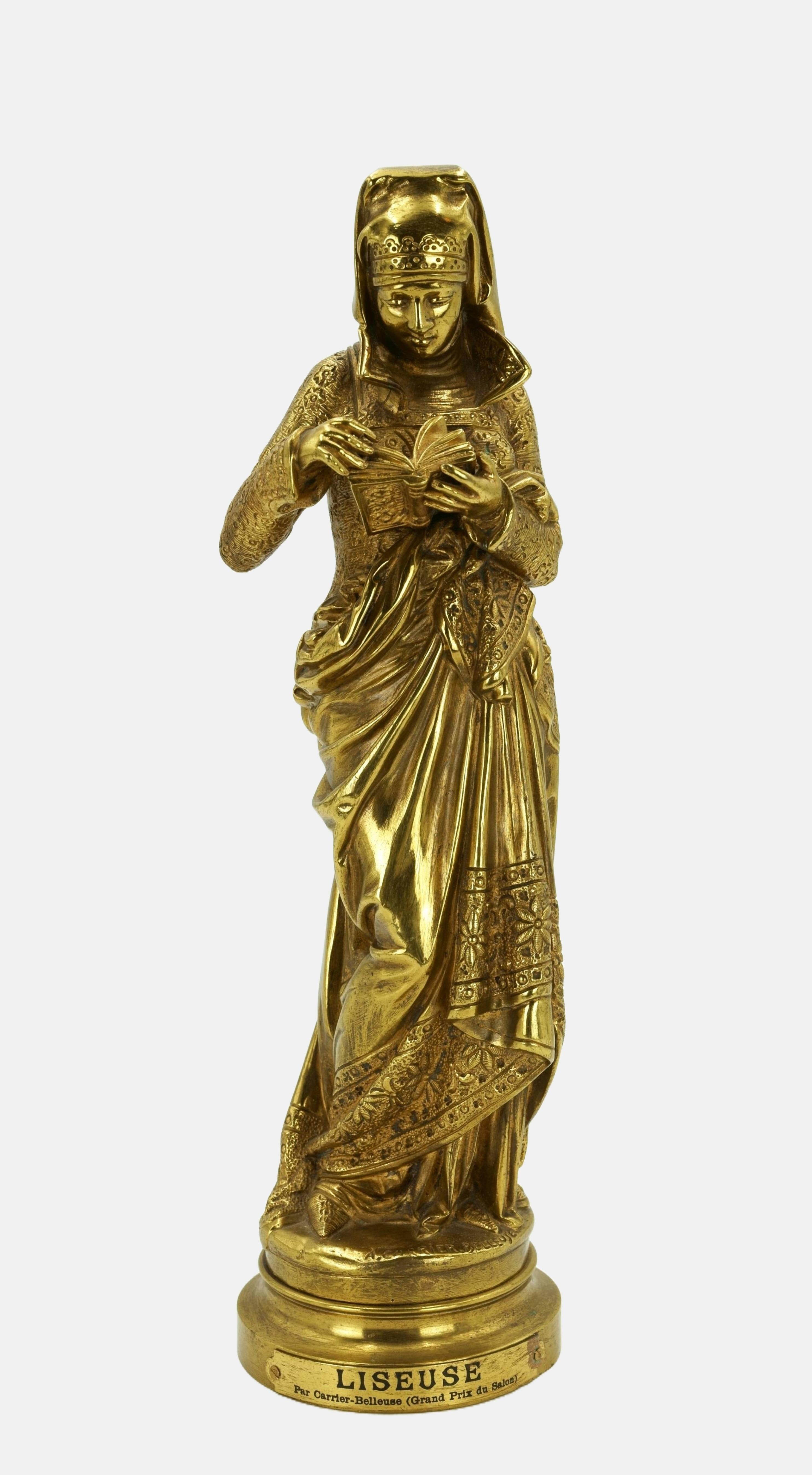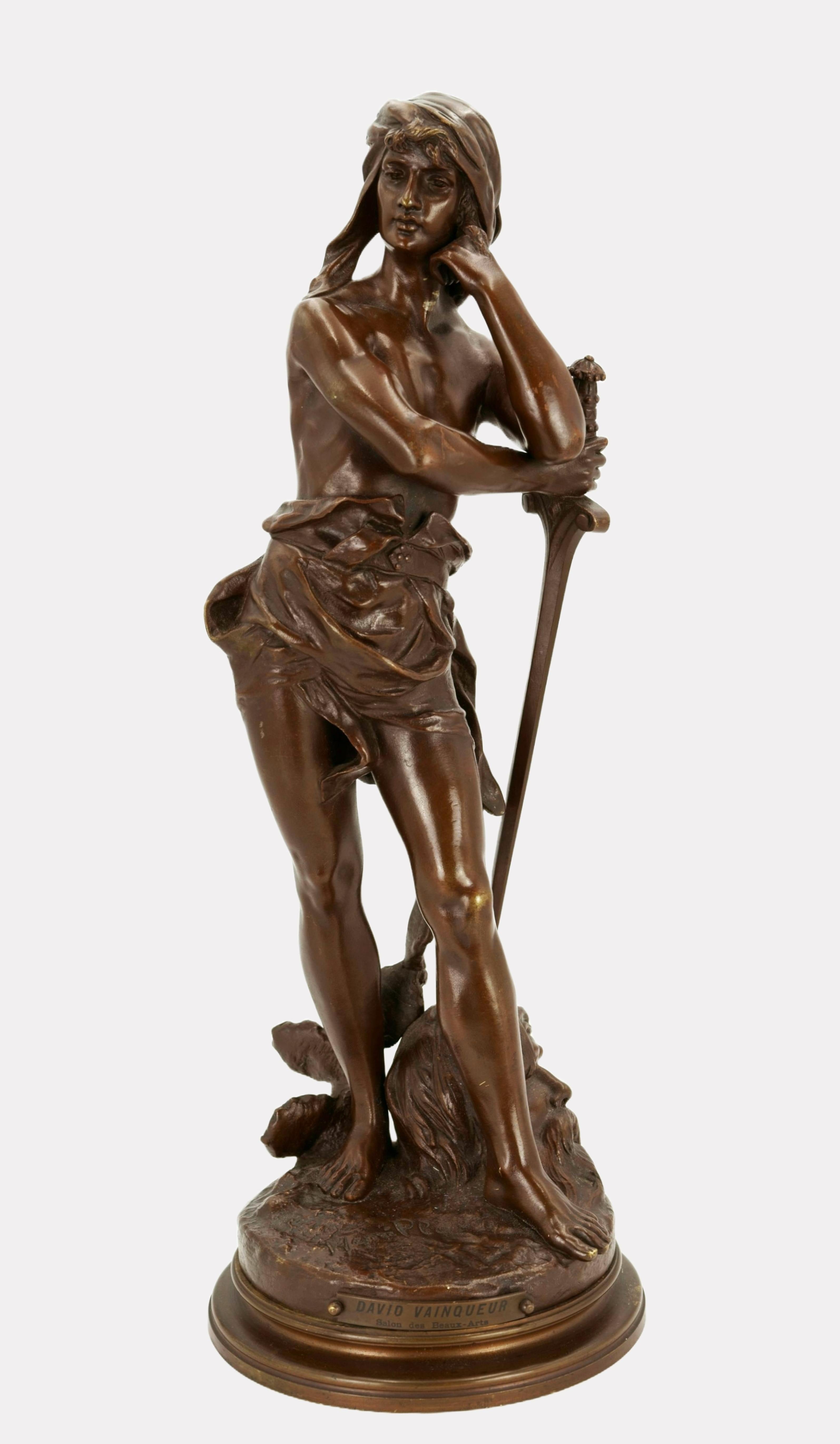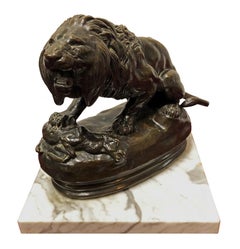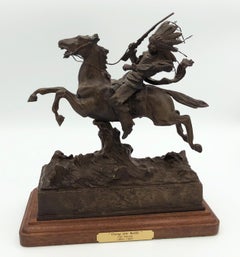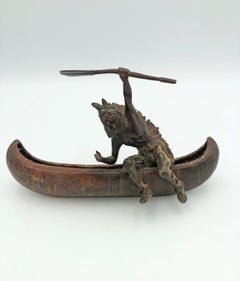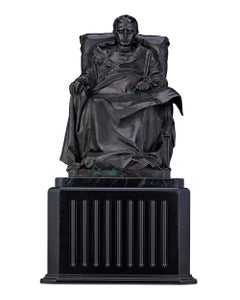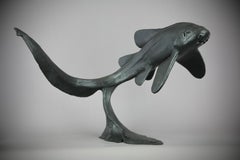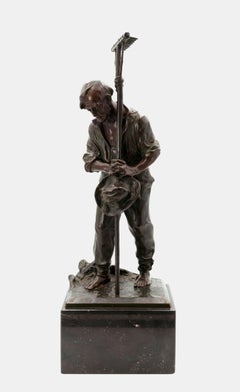Items Similar to Chien Braque (Tom)
Want more images or videos?
Request additional images or videos from the seller
1 of 5
Pierre Jules MêneChien Braque (Tom)c. 1860
c. 1860
About the Item
Pierre Jules Mene
"Chien Braque" (Tom)
Bronze
approx. 5 x 9 x 4.25
Signed
PIERRE JULES MENE (1810-1879)
Pierre Jules Mene, (P. J. Mene), was born in Paris in March of 1810 and died in Paris at number 9 Rue de L'Entrepot on May 21, 1879. The son of a metal turner, he received his earliest teaching on sculpture and foundry work from his father, and he opened his own foundry in the 1850s, creating lost-wax castings of his sculptures in bronze. Although mostly self-taught, Mene was encouraged by sculptor Rene Compaire, and was also influenced by two painters: Edwin Landseer of England with his expressive sentimentality, as well as Carle Vernet of France, in capturing spirit, grace and compositional beauty in sculptural form.
Much of Mene's early studies were made at the "Jardin des Plantes" in Paris, where he developed great talent for animal sculpture. He first exhibited the bronze statuette entitled Dog and Fox at the Paris Salon in 1838, and from that time exhibited regularly until his death. He received four awards from the Paris Salon: Second Class in 1848, First Class in 1852 and 1861, and a Third Class award in 1855. Mene did not sculpt statues, but rather bronze statuettes generally of domestic and farm animals at rest, (horses, dogs, cows, bulls, sheep and goats). He modeled over 150 subjects, and received the "Cross of the Legion of Honor" in 1861. He exhibited in England at the Great Expositions of 1855, 1867 and 1878, where he was praised as the "Landseer" of sculpture.
P. J. Mene was one of the most prolific and popular sculptors of the Animalier School, as well as one of it's earliest pioneers. His sculptures were widely collected by the public. His only sculpture acquired by the State of France during his lifetime was the bronze Mounted Huntsman and His Hounds. Charming and charismatic, Mene was accepted socially within the various French artistic communities.
Mene's earliest works, (such as Tiger and Alligator), reflected Antoine-Louis Barye's influence, but in contrast with the romantic style of Barye, Mene's style evolved in a contrasting way. He excelled in realistic portrayals of animals, sculpting each in their natural habitat, capturing fleeting movements and delicate details. Generally, his sculptures were portraits with a hint of human personality. Mene was praised for his "perfection in modeling the figures of animals, and for the truth and beauty of his representations." He worked in the Juste Milieu, blending romantic and naturalist elements while retaining a degree of traditionalism.
Mene's casts were of the highest quality and patinas. The last cast of an addition was edited as sharply as the first, and he was meticulous in the after work of his bronze casts, chiseling extremely fine details. His bronzes were signed in block letters "P. J. Mene" with no foundry marks. He taught his son-in-law, Auguste Cain, who continued Mene's foundries from 1879 to 1892. Subsequently, Mene's models were sold to the Susse Freres Foundry which cast well into the 20th century. Many recasts have been produced.
- Creator:Pierre Jules Mêne (1810 - 1879, French)
- Creation Year:c. 1860
- Dimensions:Height: 5 in (12.7 cm)Width: 9 in (22.86 cm)Depth: 4.25 in (10.8 cm)
- Medium:
- Movement & Style:
- Period:
- Condition:
- Gallery Location:Missouri, MO
- Reference Number:1stDibs: LU74733401071
About the Seller
5.0
Vetted Professional Seller
Every seller passes strict standards for authenticity and reliability
Established in 1970
1stDibs seller since 2017
154 sales on 1stDibs
Typical response time: 14 hours
- ShippingRetrieving quote...Shipping from: Missouri, MO
- Return Policy
Authenticity Guarantee
In the unlikely event there’s an issue with an item’s authenticity, contact us within 1 year for a full refund. DetailsMoney-Back Guarantee
If your item is not as described, is damaged in transit, or does not arrive, contact us within 7 days for a full refund. Details24-Hour Cancellation
You have a 24-hour grace period in which to reconsider your purchase, with no questions asked.Vetted Professional Sellers
Our world-class sellers must adhere to strict standards for service and quality, maintaining the integrity of our listings.Price-Match Guarantee
If you find that a seller listed the same item for a lower price elsewhere, we’ll match it.Trusted Global Delivery
Our best-in-class carrier network provides specialized shipping options worldwide, including custom delivery.More From This Seller
View AllLion and Antelope (No. 23)
Located in Missouri, MO
Alfred Barye (1839-1882)
"Lion and Antelope"
Bronze
Approx. 7.5H x 9W x 4D inches
Signed "BARYE.ALF" and Inscribed under base "NO. 23 LION AND ANTELOPE"
The son of a goldsmith, Parisian born Antoine-Louis Bayre was a sculptor of animal subjects and acclaimed, not only for his apparent skill, but as the founder of what became known as the French Animaliers School. Among his patrons were representatives of the state government and royalty including the Duke of Orleans and the Dukes of Luynes, Montpensier and Nemours.
Well compensated financially, he was able to buy the best of materials and hire the country's most skilled foundry craftsmen. The foundry he hired was owned by Ferdinand Barbedienne, and casts from this period were stamped with the letters, FB. However, he did not make a lot of money from his work because he was such a perfectionist that often he would not sell his work because he thought it was not 'quite right'. In 1848, he declared bankruptcy, and his molds and plaster casts were sold along with the copyrights.
Bayre's specialty was aroused, angry seeming wild game such as lions and tigers and elephants, but he also did equestrian groups and mythology figures. In order to do realistic depictions of animal anatomy, he spent much time at the Jardin de Plantes in Paris.
His early training was as an apprentice to a metal engraver, but being drafted in the army in 1812, ended that education. In 1832, he had established his own studio, and unique at that time was his method of cold stamping his bronze casts, so that each one had a special number. He had his first entry, The Milo of Croton...
Category
19th Century Realist Figurative Sculptures
Materials
Bronze
Price Upon Request
Going into Battle
By Carl Kauba
Located in Missouri, MO
Carl Kauba
"Going into Battle" c. 1920s
Bronze with Brown Patina
Signed
approx 10 x 10 x 4 (including wooden base)
This Austrian sculptor was born in Vienna in 1865. His teachers were Karl Waschmann (1848-1905), known for his ivory sculptures and portrait plaquettes of contemporary celebrities, and Stefan Schwartz (1851-1924), who exhibited in Paris, including the Exposition Universelle of 1900 where he won a gold medal. Kauba's intricate bronzes, imported to the United States between 1895 and 1912, were cast at the Roman Bronze Works. Kauba was part of the nineteenth-century tradition of polychrome bronze sculpture. There were several types of patinas on a single statue: he could render the color of buckskin, variously tinted shirts, blankets, feathers, as well as beaded moccasins. Reportedly, Kauba came to America around 1886. Inspired by the Western tales of German author Karl May, he traveled to the West and made sketches and models. Critics, however, pointed out inaccuracies of costume and other details. For instance, the guns that his "mid-nineteenth-century" figures use are models produced after 1898. Apparently he did all of his works back in Vienna.
Besides the variety of color, Kauba's bronzes show a great range of textures and his style is highly naturalistic. The sculptor loved ornament, some of which he rendered with coiled wire for reins, rope and feathers in headdresses. He successfully rendered figures in motion and often executed compositions with more than one figure. Berman (1974) illustrates non-Western subjects by Kaula, such as the pendants Where? and There (ca. 1910), a seated Scottish couple, impressive in the expressions and the details on patterned fabrics of both sitters. Another genre piece is Buster Brown...
Category
Early 20th Century Realist Figurative Sculptures
Materials
Bronze
Price Upon Request
The Hunter and Hound
By Pierre Jules Mêne
Located in Missouri, MO
Pierre-Jules Mene
"The Hunter and Hound" (Le Valet de Limier) 1879
Bronze
approx. 19 x 8 x 14 inches
Signed
PIERRE JULES MENE (1810-1879)
Pierre...
Category
1870s Realist Figurative Sculptures
Materials
Bronze
Price Upon Request
Native American in Canoe
By Carl Kauba
Located in Missouri, MO
Carl Kauba (1865-1922)
"Native American in Canoe"
Polychrome Bronze
Signed
approx 5.5 x 10 x 2.75 inches
This Austrian sculptor was born in Vienna in 1865. His teachers were Karl Waschmann (1848-1905), known for his ivory sculptures and portrait plaquettes of contemporary celebrities, and Stefan Schwartz (1851-1924), who exhibited in Paris, including the Exposition Universelle of 1900 where he won a gold medal. Kauba's intricate bronzes, imported to the United States between 1895 and 1912, were cast at the Roman Bronze Works. Kauba was part of the nineteenth-century tradition of polychrome bronze sculpture. There were several types of patinas on a single statue: he could render the color of buckskin, variously tinted shirts, blankets, feathers, as well as beaded moccasins. Reportedly, Kauba came to America around 1886. Inspired by the Western tales of German author Karl May, he traveled to the West and made sketches and models. Critics, however, pointed out inaccuracies of costume and other details. For instance, the guns that his "mid-nineteenth-century" figures use are models produced after 1898. Apparently he did all of his works back in Vienna.
Besides the variety of color, Kauba's bronzes show a great range of textures and his style is highly naturalistic. The sculptor loved ornament, some of which he rendered with coiled wire for reins, rope and feathers in headdresses. He successfully rendered figures in motion and often executed compositions with more than one figure. Berman (1974) illustrates non-Western subjects by Kaula, such as the pendants Where? and There (ca. 1910), a seated Scottish couple, impressive in the expressions and the details on patterned fabrics of both sitters. Another genre piece is Buster Brown...
Category
Early 20th Century Realist Figurative Sculptures
Materials
Bronze
Price Upon Request
Little Red Riding Hood Inkwell
By Antoine Bofill
Located in Missouri, MO
Antoine Bofill
"Little Red Riding Hood"
Bronze Inkwell
6H x 10W x 6D
Signed
Inscribed: 25 Septembre 1920
Antoine Bofill was born in Barcelona i...
Category
1920s Realist Figurative Sculptures
Materials
Bronze
Mountain Goat
By Jules Moigniez
Located in Missouri, MO
Jules Moigniez
"Mountain Goat"
Bronze
approx 11 x 9 x 4 inches
Signed
Jules Moigniez (1835-1894)
Jules Moigniez was born in Senlis sur L'Oise, France ...
Category
1870s Realist Figurative Sculptures
Materials
Bronze
You May Also Like
THE LAST DAYS OF NAPOLÉON BY
Located in New Orleans, LA
This highly evocative bronze by Vincenzo Vela captures the deposed Emperor Napoléon on his deathbed, holding a map of Europe and lost in thought about what might have been. Remarkable among most portrayals of the exiled leader, this highly detailed sculpture depicts Napoléon at his most vulnerable. Nonetheless, Vela perfectly captures his still-heroic bearing, which imparts to this work a monumental quality and quiet dignity. The mate to this figure is the colossal marble at the Musée du Château de Malmaison, which was shown at the Paris Salon of 1867.
The founder of the verismo movement in Italy, Vela was one of the great exponents of realism in sculpture. Born in Ligornetto, Switzerland in 1820, he studied under celebrated sculptor, Benedetto Cacciatori. He was also influenced both by the work of Tuscan sculptor Lorenzo Bartolini, who seamlessly combined neoclassicism with naturalism and the romantic painting of Francesco Hayez...
Category
19th Century Realist Figurative Sculptures
Materials
Marble, Bronze
Zebra Shark -original modern bronze wildlife marine sculpture - contemporary Art
By Andrzej Szymczyk
Located in London, Chelsea
This exceptional artwork is currently on display and available for sale at Signet Contemporary Art Gallery and online.
Bronze , Limited edition of 12
Enter the realm of the ocean's...
Category
21st Century and Contemporary Realist Figurative Sculptures
Materials
Bronze
In the Rough
Located in Colorado Springs, CO
Original bronze sculpture by E.C. Wynne.
Edition #110/125.
Signed on bronze.
Category
21st Century and Contemporary Realist Sculptures
Materials
Bronze
Field worker with rake / - The Humility of the Farm Worker -
Located in Berlin, DE
Paul Ludwig Kowalczewski (1865 Mieltschin - 1910 Berlin), Field worker with rake, around 1900. Brown and brown-greenish patinated bronze with cast naturalistic plinth mounted on a wh...
Category
Early 1900s Realist Figurative Sculptures
Materials
Bronze
$1,468 Sale Price
20% Off
Reading Woman / - The golden glow of imagination -
By Albert-Ernest Carrier-Belleuse
Located in Berlin, DE
Albert-Ernest Carrier-Belleuse (1824 Anizy-le-Château - 1887 Sèvres), Reading Woman, around 1880. Polished bronze mounted on a cast base. 33 cm (total height) x 9 cm (length) x 9 cm ...
Category
1880s Realist Figurative Sculptures
Materials
Bronze
$2,202 Sale Price
20% Off
The Victorious David / - The melancholy of the radiant hero -
Located in Berlin, DE
Henri Honoré Plé (1853 Paris - 1922 Paris), The Victorious David, around1890. Red-brown and brown patinated bronze with terrain plinth mounted on a round base. 42 cm (total height) x...
Category
1890s Realist Figurative Sculptures
Materials
Bronze
$1,753 Sale Price
20% Off
Recently Viewed
View AllMore Ways To Browse
Bronze Fox
Bronze Sheep
Mene Bronze
Mene Bronze Sculpture
Mene Gold
Hound Sculpture
Gold Tiger Sculpture
Pierre Mene Bronze
Bronze Sculptures Jules Mene
Pierre Jules Mene Bronze
Resting Horse Sculpture
Pierre Jules Mene Bronze Sculpture
Bronze Sculpture Goat
Cast Bronze Bull
Sheep Dog
Sheep Resting
Antique Bronze Tiger
Bronze Cow
